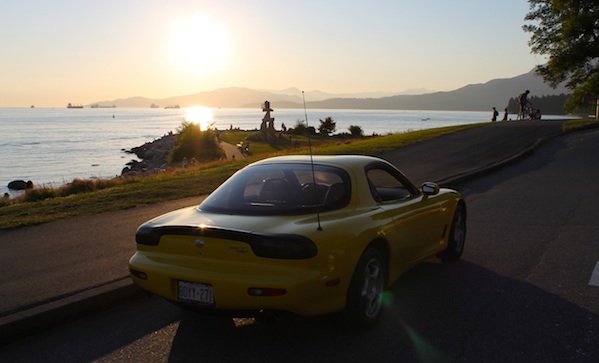The ‘90s: the heyday of the Japanese Supercar. The Acura NSX was a reliable Ferrari, the Supra Twin-Turbo was a Nipponese muscle car, and then there was the undisputed driver’s choice: the twin-turbocharged, rotary-powered third-generation Mazda RX-7.
A tendency to burn oil like a two-stroke lawn mower might cause the rotary engine to seem as out-dated as a rotary phone, but it’s not. While the absence of pistons — you get a triangle whanging around inside an oblong combustion chamber instead — makes the rotary quirkier than Zooey Deschanel’s Twitter feed, it has certain redeeming qualities.
First, an extremely compact size allows the RX-7 to carry the engine weight far behind the front axle. Second, rotaries have turbine-like revving characteristics with a tendency to scream for the rev limiter like an F-14 lighting the afterburners. Previous RX-7s had even been moderately reliable, and pretty quick with forced induction. The last of the breed would be something else entirely.
With a computer-designed chassis that weighed only a few hundred pounds more than a Miata, but much stiffer, the RX-7 boasted a desirably low centre of gravity and 50:50 weight distribution. It had super-lightweight 16” alloys that eschewed the bling for lightness, and a cozy, yet comfortable cockpit.
No traction control. No stability control. No torque-vectoring multi-wheel drive, no adjustable suspension or any other modern driving aids. Instead, for your at-the-time-astronomical $42K base, you got precision steering, a quick-shifting five-speed gearbox and that 252hp warp-drive twin-turbo rotary.
It is the sort of car built by engineers when the bean counters aren’t looking. An ode to the open pavement that’s intended to cut through a series of corners like a katana through silk. Tucked in tight behind the wheel, you feel the lack of electronic safety nets as the RX-7 pitches sideways around a curve and then powers out in the sort of slide that’d have Toyobaru owners gnawing on their drifting DVDs in envy.
Next, get that big yellow nose pointed straight and dip deeper into the power. The second turbo comes online just over 4000rpm with a distinctive whistle, and the exhaust honks with that unique rotary baritone in an exhilarating rush towards redline.
It’s an utterly fantastic machine and yet deeply, deeply flawed. The fuel economy is astronomically bad, and the high-strung nature of the twin-turbo rotary engine can make engine rebuilds a matter of course. The high initial MSRP and short production year (just three years in Canada) mean that the price of entry is still very steep.
But trust me, it’s worth it. The world wasn’t ready for this car when it burst onto the scene in 1993, and it’s still not. Banzai!


